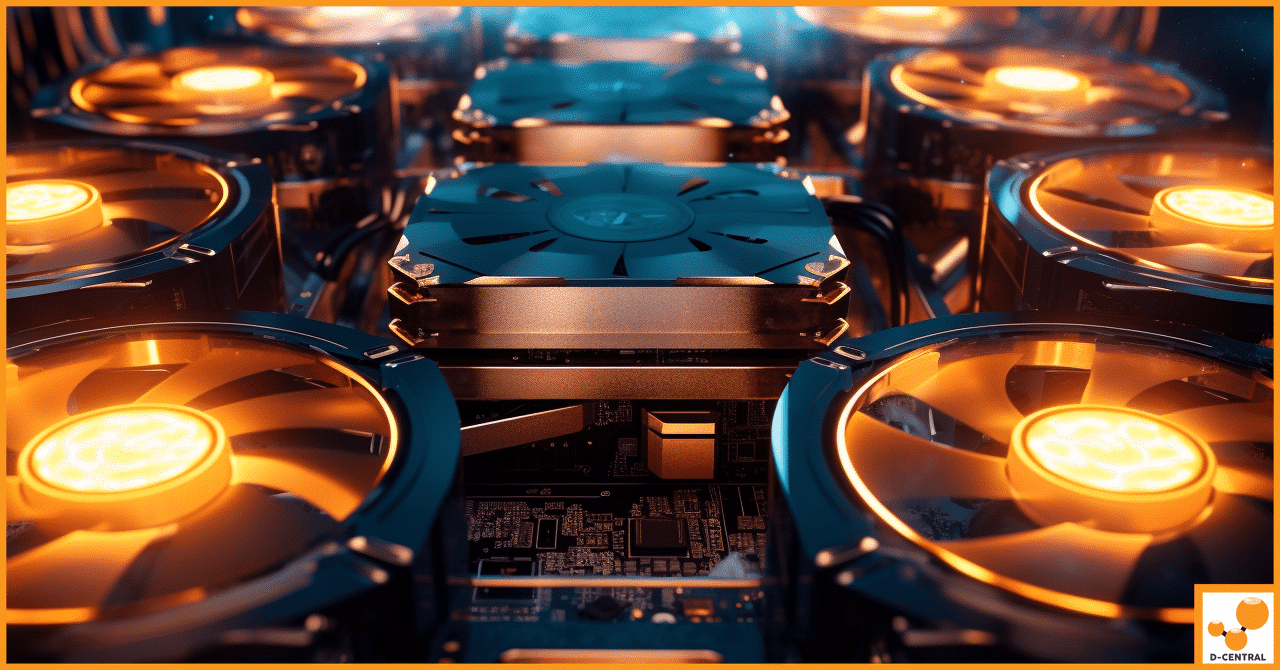
Is Proof of Work Inefficient? A Comprehensive Analysis
In the dynamic world of cryptocurrencies, the Proof of Work (PoW) consensus mechanism stands as a foundational pillar, underpinning the
4479 Desserte Nord Autoroute 440, Laval, QC H7P 6E2

In the world of Bitcoin mining, effective cooling solutions are crucial to ensure the efficient operation and longevity of mining hardware. As mining equipment generates a significant amount of heat during continuous operation, managing the temperature is essential to maintain optimal performance. Failing to properly cool your Bitcoin miners can lead to a decrease in mining efficiency, reduced hardware lifespan, and in some cases, irreparable damage to the mining equipment.
There are several cutting-edge cooling methods available, specifically designed to meet the ever-evolving demands of the Bitcoin mining industry. These include liquid cooling, immersion cooling, direct-to-chip cooling, improving air circulation, and temperature monitoring solutions. Each of these cooling methods offers unique advantages that cater to different mining setups and requirements. By understanding and implementing the most suitable cooling methods, miners can optimize their mining operations and maintain a sustainable, high-performing mining setup.
Liquid cooling is an advanced and highly efficient method for managing heat in Bitcoin mining operations. It involves the use of a liquid coolant that circulates through a closed-loop system, absorbing heat from the mining hardware and dissipating it through a heat exchanger or radiator. Liquid cooling solutions offer superior heat dissipation compared to traditional air cooling methods, enabling miners to maintain top performance even during intensive mining tasks.
There are various types of liquid coolants available for use in liquid cooling solutions. The most common coolants include:
Implementing liquid cooling solutions in Bitcoin mining operations offers several benefits, including:
Immersion cooling is an innovative and highly effective method of cooling Bitcoin mining hardware by submerging the equipment directly into a non-conductive liquid coolant. This method allows the generated heat to be directly absorbed by the coolant, resulting in rapid and uniform heat dissipation. Immersion cooling systems are different from traditional liquid cooling, as they do not require pumps, hoses, or radiators, making them simpler and potentially more cost-effective cooling solutions.
Using immersion cooling in mining operations offers several advantages, such as:
When implementing immersion cooling in your mining operations, consider the following best practices and tips:
Direct-to-chip cooling is a highly targeted method of managing heat in Bitcoin mining hardware. As the name suggests, this cooling technique focuses on dissipating heat directly from the primary heat-generating components, such as the processor or GPU chips. Direct-to-chip cooling typically involves attaching a specialized heat sink or cooling block to the surface of the chip, allowing efficient heat transfer through thermally conductive materials.
Various materials can be used for direct-to-chip cooling, depending on their thermal conductivity properties. Some examples include:
Implementing direct-to-chip cooling in Bitcoin mining operations can offer several benefits, such as:
Choosing a geographically cooler region for your mining operation can play a significant role in temperature management. Cooler climates provide natural environmental benefits, reducing the need for extensive cooling systems and lowering overall operational costs. By setting up your mining operation in a location with lower average temperatures, you can take advantage of the ambient surroundings and make it easier to maintain optimal hardware performance.
Another effective approach to optimizing temperature management in mining operations is utilizing underground facilities. Some advantages of underground facilities include:
By strategically selecting an appropriate location for your mining operation, whether in a cooler region or utilizing underground facilities, you can significantly improve temperature management and optimize the overall efficiency of your mining setup.
Rack-mount cooling fans play an important role in improving air circulation in mining setups. These fans are specifically designed to attach to the mining equipment racks, helping to draw hot air away from the hardware and exhaust it outside the mining environment. Rack-mount cooling fans come in various sizes and airflow ratings, enabling them to effectively cater to different mining setups. Their advantages include:
Ducted airflow is a powerful solution for improving air circulation in mining setups. Ducted systems use a network of ducts to distribute conditioned air throughout the mining environment, ensuring even and unrestricted airflow. Benefits of ducted airflow solutions include:
By implementing rack-mount cooling fans and ducted airflow solutions, you can significantly improve air circulation in your mining setup and achieve better cooling efficiency for your mining hardware.
Regular dust cleaning is crucial for maintaining the efficiency and performance of your Bitcoin mining equipment. Dust and debris accumulation can obstruct air circulation and negatively impact the cooling system, leading to increased temperatures and potential hardware failure. To ensure your mining hardware operates optimally, adhere to the following maintenance steps:
Additionally, consider adjusting your maintenance schedule based on the location and usage of your mining equipment. For example, equipment in a dusty environment or heavy usage may require more frequent cleaning.
Detecting and replacing faulty components in your Bitcoin mining equipment is essential for maintaining optimal performance and preventing catastrophic failures. To effectively identify and replace faulty parts, follow these steps:
By conducting regular inspections and keeping a close eye on the performance of your mining equipment, you can detect faults early and prevent major repairs, thus ensuring the longevity and efficiency of your Bitcoin mining operation.
Power efficiency is a critical factor in Bitcoin mining operations as it directly impacts profitability. One way to optimize power usage is by selecting mining software that is specifically designed for power efficiency. Such software can effectively manage hardware resources and computation tasks, ensuring the best performance with minimal energy draw. Some popular power-efficient mining software includes:
Incorporating renewable energy sources into your mining operation is an environmentally friendly and sustainable way to power your mining hardware while reducing operational costs. Some popular renewable energy options include:
By implementing power-efficient mining software and renewable energy sources, you can optimize power usage, decrease operational costs, and improve the sustainability of your Bitcoin mining operations.
Temperature sensors are essential tools for maintaining optimal performance and efficiency in Bitcoin mining operations. By integrating temperature sensors into your mining setup, you can constantly monitor the temperatures of your mining equipment and the surrounding environment. This real-time data enables you to make informed decisions about temperature management and prevent potential hardware damage due to overheating. Some popular types of temperature sensors include:
To further enhance temperature monitoring, you can employ remote monitoring solutions that provide real-time visibility of your mining operation’s thermal conditions from a distance. These solutions often use an internet connection to transmit data to a centralized dashboard or mobile application, allowing you to monitor temperatures from anywhere. Benefits of remote temperature monitoring solutions include:
By utilizing temperature sensors and remote monitoring solutions in your mining setup, you can effectively manage hardware temperatures and maintain peak mining efficiency.
For optimal cooling performance, it’s often beneficial to integrate multiple cooling methods into your mining operation. By combining different cooling strategies, you can achieve enhanced temperature management tailored to your specific setup. For instance:
Every Bitcoin mining operation is unique and may require tailored cooling solutions to best suit its individual requirements. By customizing cooling systems, you can optimize performance and ensure long-term viability. Consider the following factors when customizing your cooling solutions:
By integrating a combination of cooling methods and customizing solutions to address your mining operation’s unique requirements, you can achieve optimal cooling performance and maximize the efficiency and profitability of your Bitcoin mining operation.
Efficient cooling systems are vital for the success of any Bitcoin mining operation. By investing in modern cooling solutions and staying up-to-date with the latest advancements, miners can optimize their hardware performance, preserve its lifespan, and enhance overall profitability.
Effective cooling systems not only ensure that mining hardware remains efficient and functional, but also contribute to the long-term sustainability of mining operations. Proper cooling management directly affects the profitability and endurance of Bitcoin mining, making it an essential aspect that cannot be overlooked.
D-Central Technologies is a leading Bitcoin mining service provider that specializes in a wide range of services, including consulting, hardware sourcing, mining hosting, ASIC repairs, maintenance training, and mining support and outsourcing. We pride ourselves on offering tailored services and round-the-clock support to meet the unique needs of each client.
If you’re a Bitcoin miner looking to optimize your mining operation, D-Central has the expertise, services, and support you need. To learn more about our comprehensive Bitcoin mining services and take your mining operation to the next level, visit our website or contact us directly. We’re excited to help you make the most of your Bitcoin mining.
Question: What are the different types of liquid coolants used in liquid cooling?
Answer: The most common liquid coolants include water, propylene glycol, ethylene glycol, and mineral oil.
Question: What are the benefits of using immersion cooling in mining operations?
Answer: Benefits of immersion cooling include superior cooling efficiency, reduced energy consumption, noise reduction, simplified maintenance, and enhanced hardware lifespan.
Question: What are the benefits of utilizing underground facilities for Bitcoin mining?
Answer: Benefits of underground facilities include stable temperatures, reduced energy consumption, increased security, noise reduction, and protection from weather elements.
Question: How can renewable energy sources be used in Bitcoin mining operations?
Answer: Popular renewable energy options for mining operations include solar power, wind power, and hydroelectric power.
Question: What is D-Central, and what services do they offer?
Answer: D-Central Technologies Inc is a leading Bitcoin mining service provider specializing in consulting, hardware sourcing, mining hosting, ASIC repairs, maintenance training, and mining support and outsourcing. They offer tailored services and round-the-clock support to meet the unique needs of each client.
DISCLAIMER: D-Central Technologies and its associated content, including this blog, do not serve as financial advisors or official investment advisors. The insights and opinions shared here or by any guests featured in our content are provided purely for informational and educational purposes. Such communications should not be interpreted as financial, investment, legal, tax, or any form of specific advice. We are committed to advancing the knowledge and understanding of Bitcoin and its potential impact on society. However, we urge our community to proceed with caution and informed judgment in all related endeavors.
Related Posts

In the dynamic world of cryptocurrencies, the Proof of Work (PoW) consensus mechanism stands as a foundational pillar, underpinning the
In the intricate world of Bitcoin mining, location plays a pivotal role that often goes beyond the mere physical placement

In the rapidly evolving world of cryptocurrency mining, Application-Specific Integrated Circuits (ASICs) have emerged as the linchpin of efficiency and